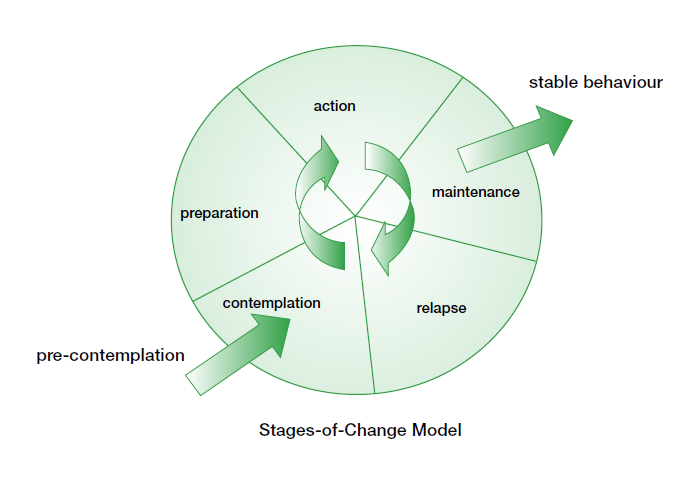Content Status
Type
Linked Node
The stages of change model
Learning ObjectivesExplain the stages of change model for behavioural change
H5Content
Content
The stages of the change model in behaviour change communication include:
- Pre-contemplation stage
- Not yet acknowledging that there is a problem behaviour that needs to be changed.
- People are not thinking seriously about changing and are not interested in any kind of help. People in this stage tend to defend their current bad habit(s) or dangerous situation(s) and do not feel it is a problem. They may be defensive in the face of other people’s efforts to pressure them to take action.
- Example: Refusing to go for TB diagnosis.
- Contemplation stage
- Acknowledging that there is a problem but not yet ready or sure of wanting to make a change.
- In this stage, people weigh the benefits and the negative aspects of modifying their behaviour. Although they think about the negatives of their bad habit or situation and the positives associated with doing something about it, they may doubt that the long-term benefits associated with taking action will outweigh the short-term costs.
- People are more open to receiving information about their bad habits or dangerous situation, and more likely to actually use educational interventions and reflect on their own feelings and thoughts concerning their bad habits or situation.
- Preparation/ determination stage
- Getting ready to change.
- People have made a commitment to make a change. They take small steps toward changing their situation. They are trying to gather information about what they will need to do to change their behaviour.
- Example: They may talk to a healthcare provider or a friend, trying to find out what resources are available to help them.
- Too often, people skip this stage; they try to move directly from contemplation to action and fail because they have not adequately researched or accepted what it is going to take to make a behaviour change.
- Action/ willpower stage
- Changing behaviour.
- This is the stage where people believe they have the ability to change and are actively involved in taking steps to change their bad behaviour or dangerous situation by using a variety of different techniques.
- Shortest of all stages.
- This is a stage when people depend mostly on their own willpower. They are making overt efforts to change their behaviour and are at the greatest risk of moving back to their previous, negative behaviour or situation.
- They may use short-term rewards to sustain their motivation and analyse their behaviour change efforts in a way that enhances their self-confidence.
- People in this stage also tend to be open to receiving help and are also likely to seek support from others.
- Maintenance stage
- Maintaining the behaviour change.
- Maintenance involves being able to successfully avoid any temptations to return to a bad habit or dangerous situation. The goal is to maintain the new status quo.
- People in this stage tend to remind themselves of how much progress they have made.
- People in maintenance constantly reformulate the rules of their lives and are acquiring new skills to deal with life and avoid returning to their previous behaviour or situation.
- They are able to anticipate the situations in which this could occur and prepare coping strategies in advance. Even though they may have thoughts of returning to their old habits or situations, they resist the temptation.
- Relapse stage
- Returning to former behaviour and abandoning the new changes.
- Relapse is often accompanied by feelings of discouragement and seeing oneself as a failure.
- While relapse can be discouraging, the majority of people who successfully change do not follow a straight path to a lifetime free of negative behaviour or situations. Rather, they cycle through the five stages several times before achieving a stable behaviour change.
- The stages-of-change model considers relapse to be normal.

Figure: Stages of Change Model in Behaviour Change Communication; Source: Advocacy, Communication & Social Mobilization (ACSM) for Tuberculosis Control - A Handbook for Country Programmes, WHO, 2007.
Resources
- Advocacy, Communication & Social Mobilisation (ACSM) for Tuberculosis Control - A Handbook for Country Programmes, WHO, 2007.
- Operational Handbook on Advocacy, Communication & Social Mobilisation for RNTCP, Central TB Division, MoHFW, GoI, 2014.
Assessment:
| Question | Answer 1 | Answer 2 | Answer 3 | Answer 4 | Correct answer | Correct explanation | Page id | Part of Pre-test | Part of Post-test |
| The stages of change model consider relapse to be normal. | True | False | 1 | While relapse can be discouraging, the majority of people who successfully change do not follow a straight path to a lifetime free of negative behaviour or situations. Rather, they cycle through the five stages several times before achieving a stable behaviour change. The stages-of-change model considers relapse to be normal. | | Yes | Yes |
LMS Page Link
Content Creator
Reviewer
Target Audience
- Log in to post comments